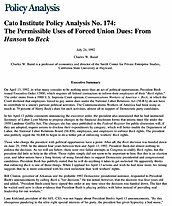On April 13, 1992, in what many consider to be nothing more than an act of political opportunism, President Bush issued Executive Order 12800, which requires all federal contractors to inform their employees of their “Beck rights.” The order stems from a 1988 U.S. Supreme Court opinion, Communications Workers of America v. Beck, in which the Court declared that employees forced to pay union dues under the National Labor Relations Act (NLRA) do not have to contribute to a union’s partisan political activities. The Communications Workers of America had been using as much as 79 percent of Harry Beck’s dues for such activities, almost all in support of Democratic party candidates.
In his April 13 public comments announcing the executive order, the president also announced that he had instructed Secretary of Labor Lynn Martin to propose changes in the financial disclosure forms that unions must file under the 1959 Landrum-Griffin Act. The changes she has since published in the Federal Register for public discussion will, if they are adopted, require unions to disclose their expenditures by category, which will better enable the Department of Labor, the National Labor Relations Board (NLRB), employees, and employers to enforce Beck rights. The president also publicly urged the NLRB to begin to do a better job of enforcing workers’ Beck rights.
Those who charge the president with political opportunism have a point. After all, the Beck decision was handed down on June 29, 1988. In the almost four years between then and April 13, 1992, President Bush did almost nothing to enforce the decision. As we will see below, there were two failed attempts in Congress to codify Beck rights, but the president did little to help in the effort. Those rights simply did not seem to be important to him. But this is an election year, and labor unions have a long history of using forced dues to support Democratic presidential and congressional candidates. President Bush has publicly stated that he will do anything it takes to get reelected. He apparently thinks that enforcing Beck is one of those things. While I applaud his April 13 actions and wish he had done more, his timing suggests that he is more concerned with his own reelection than with workers’ rights.
Bill Clinton, governor of Arkansas and the probable 1992 Democratic presidential nominee, responded to President Bush’s announcements by calling Beck a “fair decision.” He too noted, however, that the decision was four years old and added, “President Bush could have signed this order at any time since the decision was handed down. The fact that he waited until now is clear evidence that President Bush is playing politics with labor instead of providing real leadership for our workers.”
Lane Kirkland, president of the AFL-CIO, was not happy about President Bush’s April 13 announcements. “By this obsequious pandering to the ultra-right special interests of his party, the president has given hypocrisy a bad name,” said Kirkland. Inasmuch as the Beck decision was written by Justice William Brennan, with dissents from Justices Scalia, O’Connor, and Blackmun, Kirkland himself could well be accused of hypocrisy. At bottom, however, the issue has nothing to do with ultra-right (or left) politics. It is about basic human rights for all workers.
Market liberals who might be tempted to argue that the decision improperly imposes government regulation on purely private contractual relationships must realize that no collective-bargaining contract under the NLRA can rightly be considered a private voluntary exchange relationship. Indeed, under that statute, government coercion pervades the entire collective-bargaining process. What the Beck decision does, in fact, is mitigate an otherwise intolerable situation brought about by government in the first place. In a nutshell, it enables a worker, already compelled to pay dues to a union as a condition of continued employment, to withhold that portion of his dues that the union would otherwise spend for purposes of which he may disapprove, such as partisan political activities.
To illustrate those points, I will begin by examining the three principles embodied in the NLRA–exclusive representation, union security, and mandatory bargaining in “good faith”–on which coerced payment of union dues is based. Second, I will discuss whether there is government action in union security arrangements. Third, I will suggest a taxonomy of union expenditures that helps to clarify the issues raised in the series of Supreme Court cases that culminated in Beck. Fourth, I will review the case history, starting with the 1956 Hanson decision. While Beck involved private-sector employment under the NLRA, all the preceding cases involved either employment under the Railway Labor Act (RLA) or public-sector employment. As we will see in the case history, there can be no doubt that the statute-based restrictions in the RLA cases apply to comparable questions under the NLRA. The Court said so in Beck on the grounds that the relevant statutory provisions of the two acts are almost identical. However, it is arguable that the Court will not apply the constitutional restrictions it imposed in the public-sector cases to forced dues disputes under the NLRA. It was silent on constitutional questions in Beck. I will explain why I think there is sufficient government action in the NLRA to apply the constitutional restrictions imposed in the public-sector cases to NLRA cases. Then I will report on problems that have emerged in the enforcement of Beck, Congress’s two failed attempts to codify the decision, and the details of President Bush’s April 13 measures. In conclusion, I will offer some conjectures about the impact of the Beck ruling on unions and discuss the responsibilities of the Department of Labor and the NLRB.

This work is licensed under a Creative Commons Attribution-NonCommercial-ShareAlike 4.0 International License.

